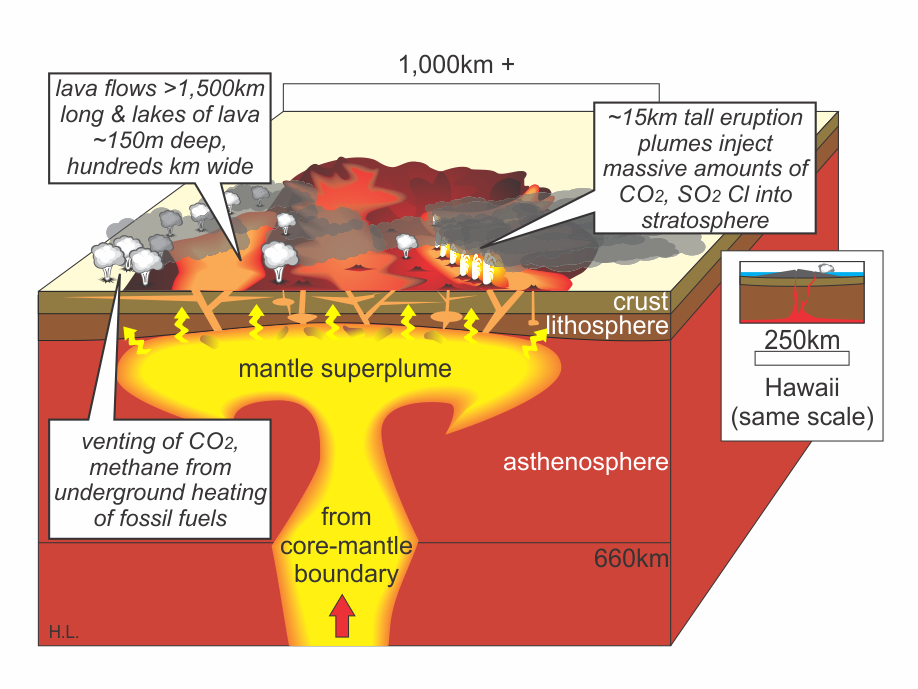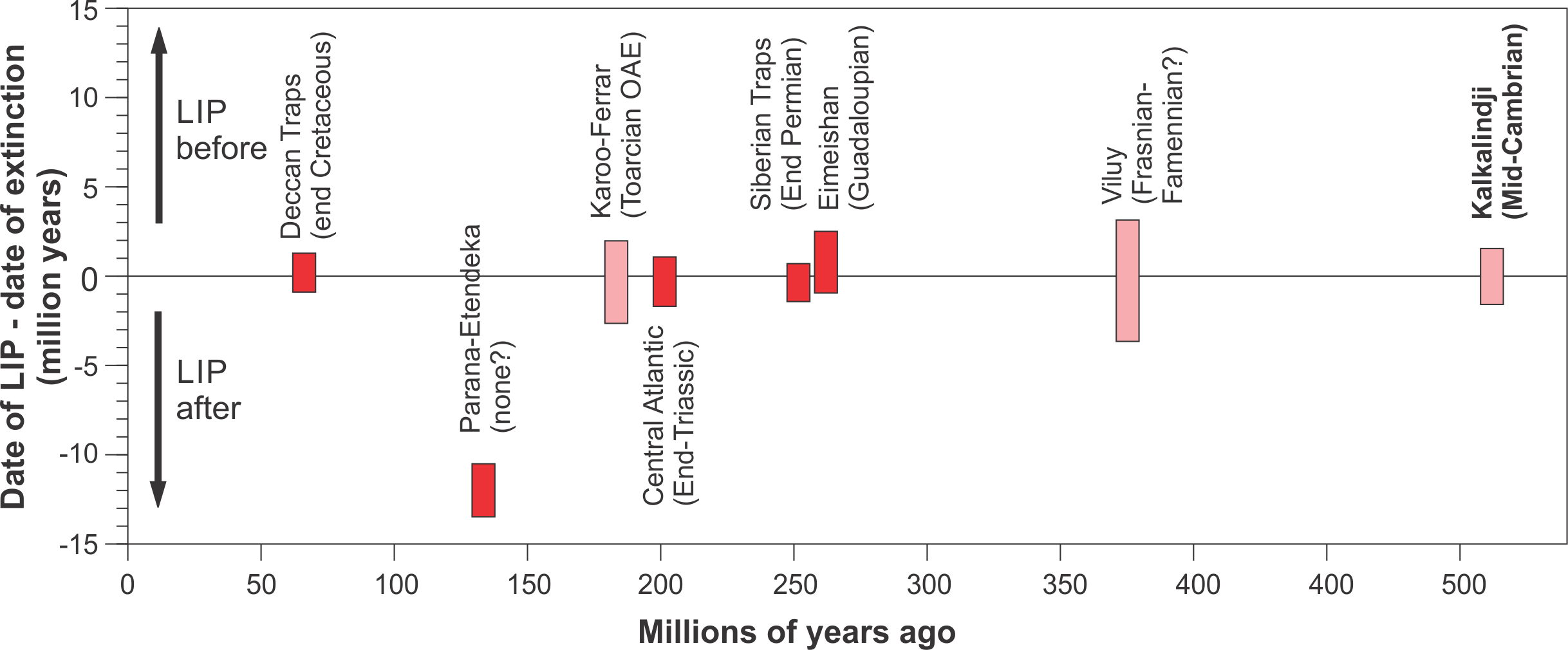 A Large Igneous Province (LIP) during eruption, loosely based on Svensen et al EPSL 2009, Howarth et al Lithos 2014, Elkins-Tanton GSA Spec Pub 2005, Keller et al J Geol Soc India 2011, Li et al Nature Geoscience 2014
A Large Igneous Province (LIP) during eruption, loosely based on Svensen et al EPSL 2009, Howarth et al Lithos 2014, Elkins-Tanton GSA Spec Pub 2005, Keller et al J Geol Soc India 2011, Li et al Nature Geoscience 2014The link between rapid climate changes and mass extinctions has been strengthened in a recent paper by Jourdan et al in “Geology.” The authors demonstrate that the extraordinarily huge volcanic eruptions of the Kalkarindji Large Igneous Province (LIP) in Australia were synchronous with a major extinction event in the middle of the Cambrian Period, and they also show that most of the severe extinctions in the Phanerozoic (the time since the beginning of the Cambrian Period) have coincided with rapid climate changes brought about by greenhouse gas and sulfur emissions by LIPs like Kalkarindji, the Siberian Traps, and others.
The “Cambrian Explosion” 541 million years ago was the dawn of the sort of complex animal life on Earth that we would recognize today – including creatures with shells and skeletons - which burst into the fossil record at that time. Yet this early proliferation of animal life was cut short 510.0 million years ago by the Mid-Cambrian extinction in which around 45% of genera went extinct. They did so at exactly the same time that the violent Kalkarindji eruptions let rip across an area around 1/3 the size of Australia, in a geological instant (less than 3 million years, possibly even less but this is the limit of the dating resolution). It wasn’t until 25 million years later in the Ordovician Period that life regained its radiative momentum in the Great Ordovician Biodiversification Event (GOBE).
Jourdan et al state that: “Although rapid climate changes and climate oscillations are likely to be the ultimate cause of mass extinctions, the exact trigger mechanisms arising from LIP emplacements that are responsible for these climatic shifts are less clear.” They note that the vast quantities of magma alone would result in huge releases of CO2 and SO2, and the extraordinary violence of the eruptions would have delivered these gasses to the stratosphere. In addition, sheets of magma injected underground would have baked oil-rich sediments, releasing methane and even more CO2. In fact, blobs of asphalt can be seen in the Australian lava. These attributes are all remarkably similar to the circumstances surrounding the Permian Mass Extinction, in which most complex life on earth was extinguished, as described in an earlier post here.
 A Large Igneous Province (LIP) during eruption, loosely based on Svensen et al EPSL 2009, Howarth et al Lithos 2014, Elkins-Tanton GSA Spec Pub 2005, Keller et al J Geol Soc India 2011, Li et al Nature Geoscience 2014
A Large Igneous Province (LIP) during eruption, loosely based on Svensen et al EPSL 2009, Howarth et al Lithos 2014, Elkins-Tanton GSA Spec Pub 2005, Keller et al J Geol Soc India 2011, Li et al Nature Geoscience 2014
LIP eruptions are very different from the volcanic eruptions that have occurred in the span of human history. The last LIP was the eruption of the Columbia River Basalts in the US northwest, 16 million years ago, long before the evolution of hominins from apes. Most volcanic eruptions have a temporary cooling effect from their sulfur emissions, and collectively over many millions of years their CO2 emissions keep the planet from freezing solid. LIPs, in contrast, tend to generate strong global warming through the huge quantities of greenhouse gasses they emit in a comparatively short time. The work of Jourdan et al adds to the list of extinction events that coincided with LIPs, and the severe climate fluctuations that accompanied them. Even at the end-Cretaceous, when most scientists agree a giant asteroid impact wiped out the dinosaurs, an episode of strong global warming had already triggered a major extinction event just before the impact. The authors note that the correlation between LIPs and severe extinctions is now so strong that there is a “negligible 6×10–9% probability that such correlation is due to chance alone,” which “strongly supports a causal relationship between the LIPs and severe extinctions during the Phanerozoic.”
The Mid-Cambrian extinction, occurring before colonization of land by plants and animals, also suggests that the LIP kill mechanism is unlikely to have been associated with ozone layer collapse, as was recently suggested for the Permian Mass Extinction. So oceans must be critical to the extinction mechanism (see this post), which points the finger even more clearly at rapid greenhouse-gas and sulfur aerosol-driven climate fluctuations as the cause of Earth’s largest mass extinctions.
Asteroid impacts, in contrast, have peppered our planet relatively often over the same time period, but the only Phanerozoic mass-extinction coincident with a large impact was the end-Cretaceous impact (which occurred on top of a LIP-triggered climate change as mentioned above). The popular image of asteroid impacts as the ultimate annihilator of life may be dramatic and make for exciting movies, but the hard reality is that rapid climate changes, such as humans are unleashing on the planet today, have consistently been more deadly to life on Earth.

Synchronicity between Large Igneous Province eruptions (LIPs) and large extinction events. Red denotes dated duration, pink denotes date uncertainty. See Jourdan et al for explanation of Paranà-Etendeka LIP. Redrawn from Jourdan et al, Geology 2014.
Posted by howardlee on Tuesday, 27 May, 2014
 |
The Skeptical Science website by Skeptical Science is licensed under a Creative Commons Attribution 3.0 Unported License. |